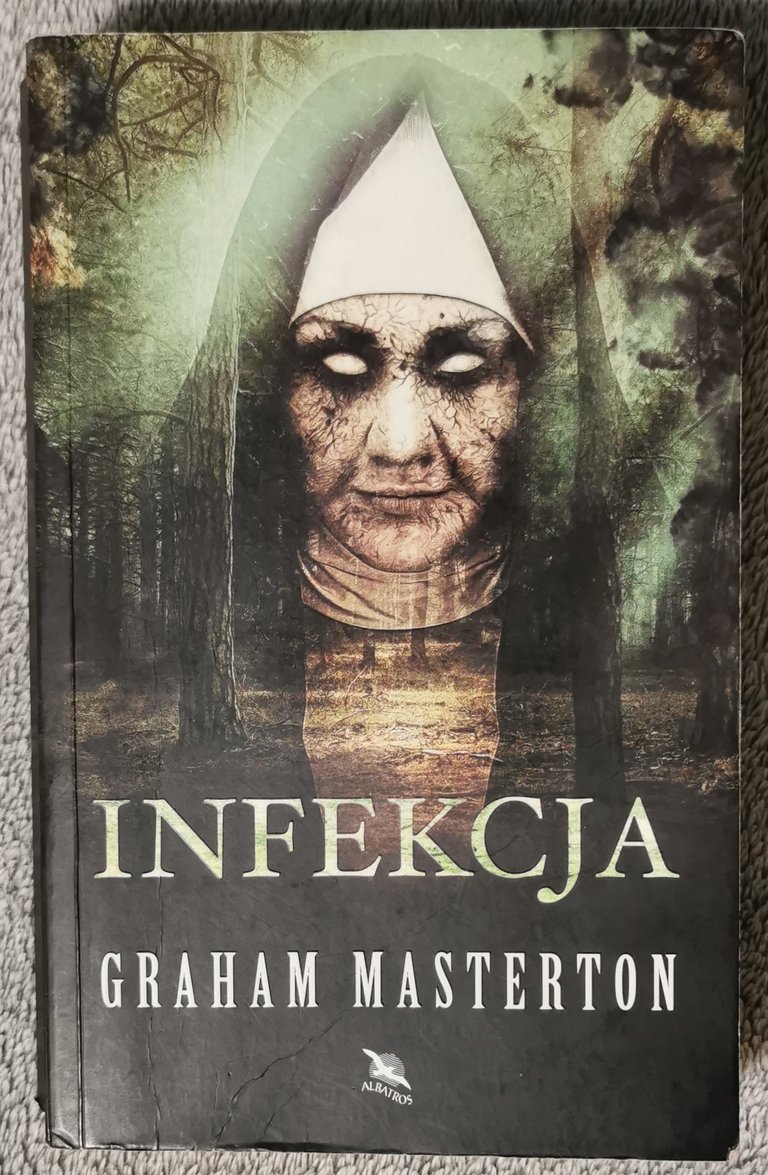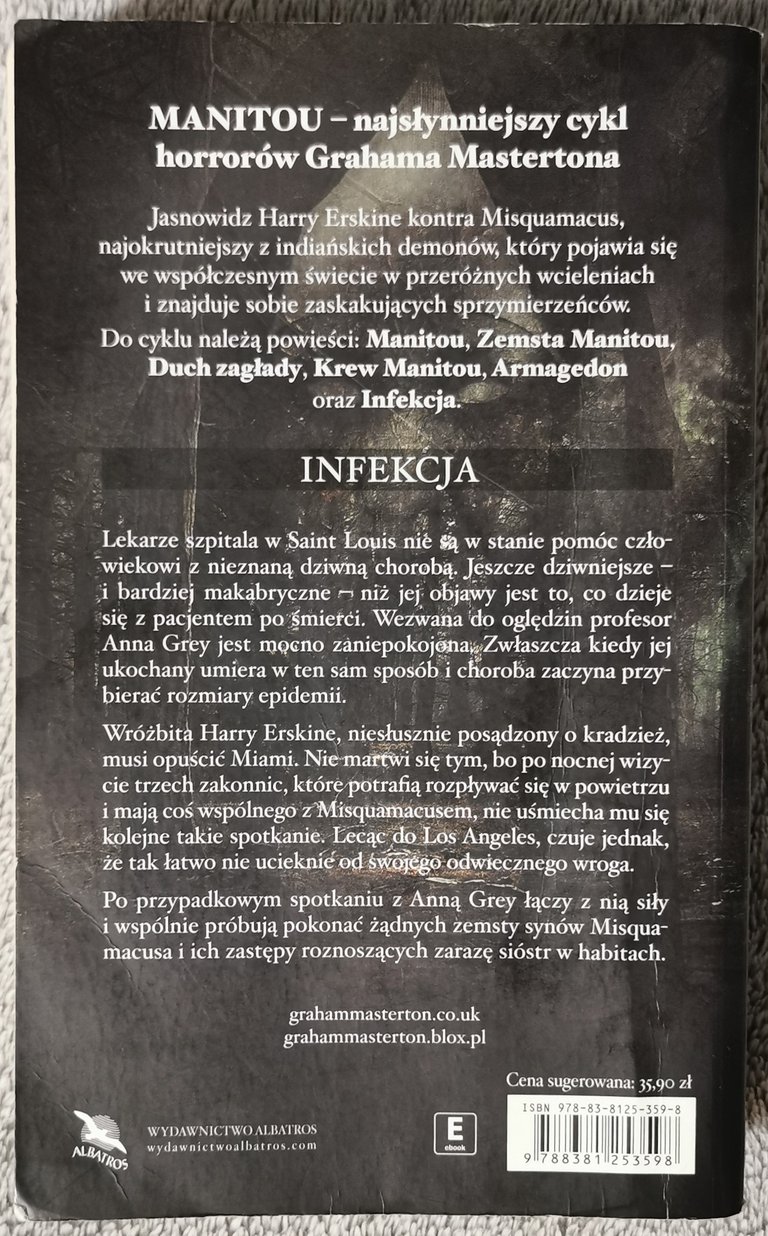| W dzisiejszym odcinku przedstawiam Wam aktualnie ostatnią powieść z cyklu o Manitou autorstwa Grahama Mastertona. Jest to rzecz względnie nowa (ale bez przesady – oryginał ukazał się w 2015, polski przekład w 2019) i po „Armagedonie” właściwie nieoczekiwana. Ale nawet jeśli Misquamacus został faktycznie zniszczony i odesłany w niebyt (chociaż z nim to nigdy nie wiadomo...), to – jak się okazuje – wcale jeszcze nie oznacza, że spokój z indiańskimi czarownikami i duchami mamy na zawsze. |
In today's episode I am going to introduce you to the latest novel in the Manitou series by Graham Masterton. It's relatively new (but not too much - the original was published in 2015, the Polish translation in 2019) and, after 'Manitou Armagedon/Blind Panic', almost unexpected. But even if Misquamacus has indeed been destroyed and sent back to oblivion (although you never know with him...), it turns out that this does not mean that we have finally made peace with Indian sorcerers and ghosts forever. |
| Harry Erskine, zamiast sobie żyć w spokoju i zasłużenie korzystać z uroków życia w Ameryce, którą już kilkukrotnie ocalił, ponownie musi zmierzyć się z nieznanymi wrogami. Zaczyna się od epidemii dziwnej, nieuleczalnej choroby, po której zmarli zachowują się zupełnie inaczej, niż to porządnym zwłokom przystoi. Z kolei samego Harry’ego nawiedzają trzy złowrogie, niematerialne zakonnice, a karty tarota ponownie ostrzegają przed nadchodzącym kataklizmem. Jak można się domyślić – oba wątki w pewnym momencie się łączą. |
Instead of living in peace and deservedly enjoying the charms of life in the America he has already saved several times, Harry Erskine has to face unknown enemies once again. It all starts with the outbreak of a strange, incurable disease that causes the dead to behave in a way that is completely different from what a decent corpse should do. Harry himself is haunted by three sinister, immaterial nuns, and tarot cards once again warn of an impending cataclysm. As you might have guessed - the two threads do come together at a certain point. |
| Co wspólnego łączy ród Misquamacusa z XVII-wiecznym rozpustnym francuskim księdzem? Pozornie nic, a jednak bardzo wiele. Zawiązuje się niezwykły sojusz skierowany ponownie przeciwko Ameryce i Amerykanom, oparty na nienawiści do chrześcijańskiego Kościoła. I tym razem zdolności Harry’ego mogą się okazać niewystarczające – tym bardziej, że po jego stronie tym razem zabraknie Śpiewającej Skały. A stawką jest, jak zwykle, życie setek milionów ludzi. |
What do the Misquamacus family and a debauched 17th century French priest have in common? Nothing, it seems, but quite a lot. An unusual alliance is formed, once again against America and Americans, based on hatred of the Christian Church. And this time Harry's skills may not be enough - especially as the Singing Rock is missing from his side this time. And, as always, the lives of hundreds of millions of people are at stake. |
| Czy jest to powieść udana? To niełatwe pytanie. Pomysł, by pałeczkę po nieszczęsnym Misquamacusie przejęli jego synowie – oceniam jako bardzo dobry. Podobnie jak sposób, który wybrali, by zemścić się na Białych – współgrający z losem, który naprawdę spotkał wiele indiańskich plemion. Idea, żeby uczynić Urbaina Grandiera białym Misquamacusem – powiedzmy, że nawet nawet, całkiem oryginalna i kreatywna. Natomiast zaproponowana czytelnikowi wizja, by zakonnice ostatecznie okazały się gigantycznymi pluskwami, oprócz rozmiarów nie różniącymi się niczym od tysięcy innych, wypełzających Matce Joannie od Aniołów (tej oryginalnej) z – takie małe niedopowiedzenie... – no nie. Po prostu nie. Oczywiście – horrory rządzą się swoimi prawami, i pewne zawieszenie realizmu i wiarygodności jest po prostu niezbędne. Ale jednak są granice, które nie powinny być przekraczane. |
Is this a successful novel? That's not an easy question to answer. This idea of his sons taking up Misquamacus' baton is a fine one. As well as is the way in which they decide to take revenge on the whites - in keeping with the fate that really befell many Indian tribes. The idea of turning Urbain Grandier into a white Misquamacus is, let's say, quite original and creative. On the other hand, the vision offered to the reader - that the nuns finally turn out to be giant bedbugs, apart from their size identical with the thousands of others that crawled out of Mother Joan of Angels' (the original one) you-know-what - such a small understatement... Well, no. Simply no. Of course - horror films have their own rules, and a certain suspension of realism and plausibility is simply necessary. But still, there are lines that should not be crossed. |
| Podsumowanie:
Książka ma sensowny rozmiar (382 strony), taki w sam raz, żeby starczyła na średniej długości podróż albo przedłużony wieczór. Jak to zwykle u Mastertona bywa – czyta się dobrze: szybko, płynnie, po prostu wciąga. To, czego czytelnicy z reguły u niego szukają, czyli sceny drastyczne i sceny, nazwijmy to, krótkouczuciowe – występują w rozsądnych proporcjach. Być może, chciałbym trochę więcej nawiązań do mitologii rdzennych Amerykanów, której przecież w cyklu Misquamacusa zawsze było sporo. W zamian jest dużo epidemiologii – w tekście oryginalnym nie robiło to aż takiego wrażenia, ale w Polsce zbiegło się dość mocno z początkami pandemii, więc wyszło bardzo fajne połączenie – choć nieplanowane przez autora. I wszystko byłoby fajnie, zmierzając ku wysokiej ocenie, gdyby nie zakończenie. Co tu dużo mówić, Masterton mistrzem zakończeń nie jest (choć, czasami, zdarzają mu się perełki również w tym aspekcie) i w „Infekcji” to, niestety, widać. Zakończenie zakonnicowo-pluskwowe bardzo psuje wrażenie i przyczynia się do obniżenia oceny.
|
Conclusion:
The book is a reasonable size (382 pages), just the right size for a medium-length journey or an extended evening. As usual with Masterton - it reads well: fast, smooth, simply engaging. What readers generally look for in his work - drastic scenes and scenes of, let's say, short emotions - are present in reasonable proportions. Perhaps I would have liked a little more reference to Native American mythology, of which there has always been plenty in the Misquamacus series. Instead, there's a lot of epidemiology - in the original text it wasn't that impressive, but in Poland it coincided quite strongly with the beginning of the pandemic, so it came out as a very cool combination - although unplanned by the author. And it would all have been cool, heading for a high rating, if it hadn't been for the ending. What can I say, Masterton is not a master of endings (although there are some gems in this aspect as well) and in "Plague of the Manitou" this unfortunately is visible. The nun-bedbug ending really spoils the impression and contributes to the lower rating.
|


An interesting review, after which I would rather skip this book than read it
Thanks! In general I would recommend it mostly to these, who have read all 5 previous parts of the series, and were satisfied with them. To start the story with that book rather makes no sense :)
The book came with a lot.
Nice review.
Thanks!
You are welcome
Yay! 🤗
Your content has been boosted with Ecency Points, by @avtandil.
Use Ecency daily to boost your growth on platform!
Support Ecency
Vote for new Proposal
Delegate HP and earn more